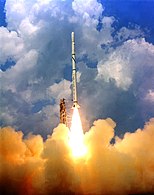
Back Vehicle de llançament lleuger Catalan وسیله نقلیه پرتاب سبک Persian Lanceur léger French Wahana peluncur berdaya angkat ringan ID Lanciatore leggero Italian 超小型衛星打上げ機 Japanese 소형 리프트 발사체 Korean Veículo de lançamento leve Portuguese Ракета-носитель малой грузоподъёмности Russian 小型運載火箭 Chinese
| Class overview | |
|---|---|
| Name | Small-lift launch vehicle |
| Preceded by | Sounding rocket |
| Succeeded by | Medium-lift launch vehicle |
| Built | Since 1957 |
| General characteristics | |
| Capacity |
|
A small-lift launch vehicle is a rocket orbital launch vehicle that is capable of lifting 2,000 kilograms (4,400 lb) or less (by NASA classification) or under 5,000 kilograms (11,000 lb) (by Roscosmos classification)[1] of payload into low Earth orbit (LEO). The next larger category consists of medium-lift launch vehicles.[2]
The first small-lift launch vehicle was the Sputnik rocket, launched by the Soviet Union, which was derived from the R-7 Semyorka ICBM. On 4 October 1957, the Sputnik rocket was used to perform the world's first satellite launch, placing the Sputnik 1 satellite into a low Earth orbit.[3][4][5] The US responded by attempting to launch the Vanguard rocket.[6][7] However, the Vanguard TV3 launch attempt failed, with the 31 January 1958 launch of the Explorer 1 satellite using the Juno I rocket being the first successful US orbital launch. The Vanguard I mission was the second successful US orbital launch. This was the start of the space race.[8][9]
Since the late 1950s, small-lift launch vehicles have continued launching payloads into orbits including LEO, Sun-synchronous orbit (SSO), and geostationary transfer orbit (GTO). Medium-lift launch vehicles, heavy-lift launch vehicles, and super heavy-lift launch vehicles have also been extensively developed but have not completely superseded small launch vehicles. Small launch vehicles can meet the requirements of some spacecraft, and can also be less expensive than a larger launch vehicle would be.[10]
- ^ Osipov, Yuri (2004–2017). Great Russian Encyclopedia. Moscow: Great Russian Encyclopedia. Archived from the original on 27 May 2021. Retrieved 9 June 2021.
- ^ NASA Space Technology Roadmaps – Launch Propulsion Systems, p. 11 Archived 24 March 2016 at the Wayback Machine: "Small: 0-2t payloads, Medium: 2-20t payloads, Heavy: 20-50t payloads, Super Heavy: >50t payloads"
- ^ "NASA – NSSDCA – Spacecraft – Details". Nssdc.gsfc.nasa.gov. Retrieved 7 February 2019.
- ^ "Sputnik launch vehicle 8K71PS (M1-1PS)". Russianspaceweb.com. Retrieved 7 February 2019.
- ^ "ЦЭНКИ – Центр эксплуатации объектов наземной космической инфраструктуры". Russian.space. Retrieved 7 February 2019.
- ^ "Vanguard Project – U.S. Naval Research Laboratory". Nrl.navy.mil. Archived from the original on 16 February 2020. Retrieved 7 February 2019.
- ^ "The Vanguard Satellite Launching Vehicle — An Engineering Summary". B. Klawans. April 1960, 212 pages. Martin Company Engineering Report No 11022, PDF of an optical copy.
- ^ Kennedy, John F. (20 April 1961). "Memorandum for Vice President". The White House (Memorandum). Boston, MA: John F. Kennedy Presidential Library and Museum. Archived from the original on 21 July 2016. Retrieved 1 August 2013.
- ^ Launius, Roger D. (July 1994). "President John F. Kennedy Memo for Vice President, 20 April 1961" (PDF). Apollo: A Retrospective Analysis. Monographs in Aerospace History Number 3. Washington, D.C.: NASA. OCLC 31825096. Archived from the original (PDF) on 9 October 2022. Retrieved 1 August 2013. Key Apollo Source Documents Archived 8 November 2020 at the Wayback Machine.
- ^ "The Space Review: The case for smaller launch vehicles in human space exploration (part 2) (page 2)". www.thespacereview.com. Retrieved 1 June 2024.


